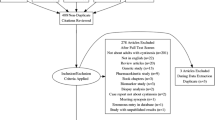Abstract
Ten children with cystinosis had their diet, serum creatinine, and total cholesterol (averaged in 6-month blocks and normalized by calculating a z score (TCz)] monitored for a mean of 5 years. The TCz scores were elevated in boys (P<0.01) but not girls (P=0.67). The boys had elevated TCz scores for 58% of their 29 pre-transplantation years of follow-up, rising as early as 1 year of age at a mean rate of 0.67 standard deviations per year. Cystinotic boys had higher TCz scores than children with other tubular disorders (P<0.025). All 4 cystinotic boys who developed renal insufficiency had a rise in TCz scores at a rate greater than control children with comparable renal impairment. Two cystinotic boys received a renal transplant; subsequent TCz scores were markedly lower, but remained elevated. The nutritional status of cystinotic children deteriorates after 3 years of age: they have decreased fat stores, elevated TCz scores and consume high fat diets insufficient in total calories. In summary, cystinotic boys have marked, progressive hypercholesterolemia which improves after renal transplantation.
Similar content being viewed by others
References
Gahl WA, Bernardini I, Dalakas M, Rizzo WB, Harper GS, Hoeg JM, Hurko O, Bernar J (1988) Oral carnitine therapy in children with cystinosis and renal Fanconi syndrome. J Clin Invest 81: 549–560
Schneider JA, Schlesselman JJ, Mendoza SA, Orloff S, Thoene JG, Kroll WA, Godfrey AD, Schulman JD (1979) Ineffectiveness of ascorbic acid therapy in nephropathic cystinosis. N Engl J Med 300: 756–759
Charnas LR, Bernardini I, Rader D, Hoeg JM, Gahl WA (1991) Clinical and laboratory findings in the oculocerebrorenal syndrome of Lowe, with special reference to growth and renal function. N Engl J Med 324: 1318–1325
Kannel WB, Castelli WP, Gordon T, McNamara PM (1971) Serum cholesterol, lipoproteins, and the risk of coronary heart disease. Ann Intern Med 74: 1–12
The Lipid Research Clinics Population Studies Data Book (1980) National Institute of Health, Bethesda, vol I, pp 28–29
Papadopoulou ZL, Sandler P, Tina LU, Jose PA, Calcagno PI (1981) Hyperlipidemia in children with chronic renal insufficiency. Pediatr Res 15: 887–891
Zacchello G, Pagnan A, Sidran MP, Ziron L, Braggion M, Pavanello L, Facchin P (1987) Further definition of lipid-lipoprotein abnormalities in children with various degrees of chronic renal insufficiency. Pediatr Res 21: 462–465
Starc TJ, Belamarich PF, Shea S, Dobrin-Seckler BE, Dell RB, Gersony WM, Deckelbaum RJ (1991) Family history fails to identify many children with severe hypercholesterolemia. Am J Dis Child 145: 61–64
Schwartz GJ, Haycock GB, Edelmann CM, Spitzer A (1976) A simple estimate of glomerular filtration rate in children derived from body length and plasma creatinine. Pediatrics 58: 259–263
McCrory WW (1972) Quantitative measurement of renal function during growth in infancy and childhood. In: McCrory WW (ed) Developmental nephrology. Harvard University Press, Cambridge, p 96
Chantler C (1979) The kidney. In: Godfrey S, Baum JD (eds) Clinical paediatric physiology. Blackwell, Oxford, p 367
Pennington JAT, Church HN (1980) Bowes and Church's food values of portions commonly used, 13th edn. Harper and Row, New York, pp 1–167
Subcommittee on the tenth edition of the RDA's Food and Nutrition Board, Commission on Life Sciences, National Research Council (1989) Recommended dietary allowances, 10th edn. National Academy Press, Washington, D.C., p 33
Hamill PV, Drizd TA, Johnson CL, Reed RB, Roche AF, Moore WM (1979) Physical growth: National Center for Health Statistics percentiles. Am J Clin Nutri 32: 607–629
Frisancho AR (1974) Triceps skin fold and upper arm muscle size norms for assessment of nutritional status. Am J Clin Nutr 27: 1052–1058
Pennisi AJ, Heuser ET, Mickey MR, Lipsey A, Malekzadeh MH, Fine RN (1976) Hyperlipidemia in pediatric hemodialysis and renal transplant patients. Am J Dis Child 130: 957–961
Asayama K, Ito H, Nakahara C, Hasegawa A, Kato K (1984) Lipid profiles and lipase activities in children and adolescents with chronic renal failure treated conservatively or with hemodialysis or transplantation. Pediatr Res 18: 783–788
Nutrition committee, American Heart Association (1986) Position statement, dietary guidelines for healthy American adults, a statement for physicians and health professionals by the nutrition committee, American Heart Association. Circulation 74: 1465A-1468A
Author information
Authors and Affiliations
Rights and permissions
About this article
Cite this article
Murphy, J.L., Papathakis, P.C. Hypercholesterolemia in children with cystinosis. Pediatr Nephrol 7, 159–162 (1993). https://doi.org/10.1007/BF00864385
Received:
Revised:
Accepted:
Issue Date:
DOI: https://doi.org/10.1007/BF00864385




